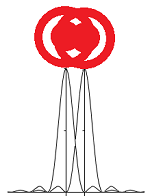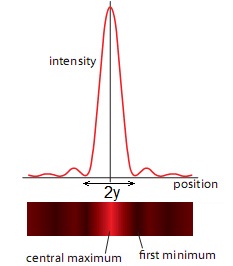 In Standard Level Waves, you learnt the basics of everything we will observe here, but with a few notable extensions.
In Standard Level Waves, you learnt the basics of everything we will observe here, but with a few notable extensions.
What is the Doppler effect? What are the effects of a moving source, observer and medium? What are the equations for simple harmonic motion? How is the diffraction pattern formed for light passing through a single slit? What affects the interference patterns for two or more slits? What is thin film interference?
Key Concepts
The Doppler effect is the change in frequency in observed sound due to relative motion between source and observer.
For a moving source and stationary observer, the observed frequency can be calculated using the following equation:
\(f'=f({v\over v\pm u_s})\)
- \(f'\) is the observed frequency
- \(f\) is the frequency emitted by the source
- \(v\) is the speed of sound (ms-1)
- \(u_s\) is the speed of the source (ms-1), where \(u_s>0\) for the source moving towards the observer
If the source is stationary and the observer moves, we adapt the equation:
\(f'=f({v\pm u_o \over v})\)
- \(f'\) is the observed frequency
- \(f_0\) is the frequency emitted by the source
- \(v\) is the speed of sound (ms-1)
- \(u_o\) is the speed of the observer (ms-1), where \(u_o>0\) for the source moving towards the observer
A sonic boom is produced when the relative speed of the source exceeds the speed of the wave in the medium.
The Doppler effect affects light waves and can be used to determine the relative speeds of objects in the universe. The light of receding objects is red shifted. The light of approaching objects is blue shifted.
\({\Delta f \over f}={\Delta \lambda \over \lambda} \approx{v\over c}\)
- \(\Delta f\) is the change in observed frequency (Hz)
- \(f\) is the frequency emitted by the source (Hz)
- \(\Delta \lambda\) is the change in the oberved wavelength (m)
- \(\lambda\) is the wavelength emitted by the source (m)
- \(v\) is the speed of the source (ms-1)
- \(c\) is the speed of light (ms-1)
Two sources of light become resolved (distinguishable as separate) when the Rayleigh criterion applies: the principal maximum of one diffraction pattern coincides with the first minimum of the other.

In the instance that the Rayleigh criterion applies, we can calculate the separation of the sources:
\(\theta=1.22{\lambda\over b} ={\text{separation}\over D}\)
- \(\theta\) is the angle subtended by the centre and the first minimum (rad)
- \(\lambda\) is the wavelength of light (m)
- \(b\) is the diameter of the aperture (m)
- \(D\) is the perpendicular distance from the centre of the two objects to the slit (m)
Diffraction gratings can be used to resolve two wavelengths of light.
\(R={\lambda\over \Delta \lambda}=mN\)
- \(R\) is the resolvance of the diffraction grating
- \(\lambda\) is the mean wavelength (m)
- \(\Delta \lambda\) is the smallest resolvable wavelength difference (m)
- \(m\) is the order of the diffraction
- \(N\) is the total number of slits illuminated
How much of AHL Waves have you understood?






 Twitter
Twitter  Facebook
Facebook  LinkedIn
LinkedIn